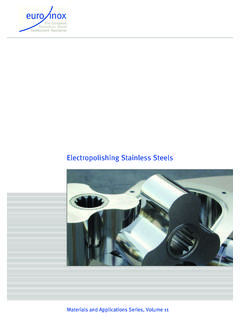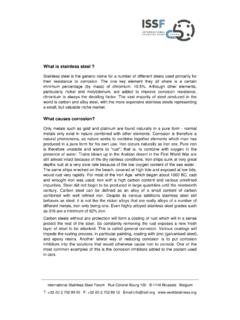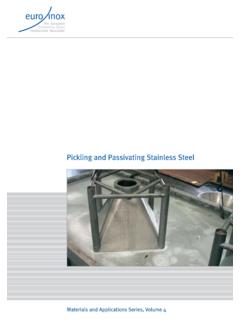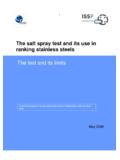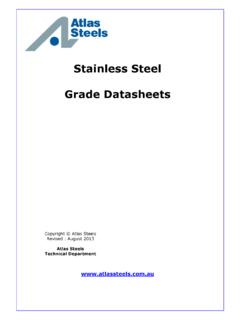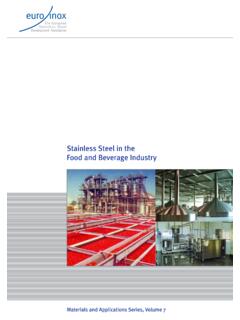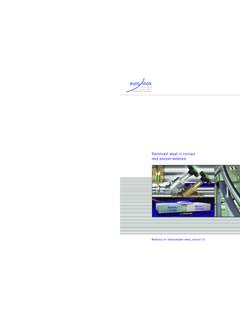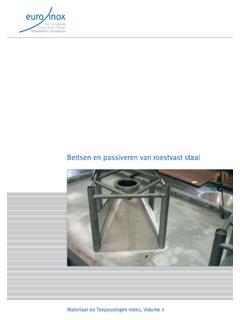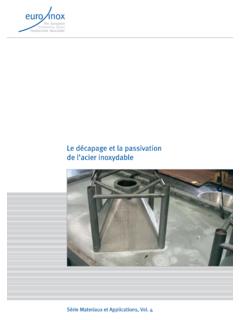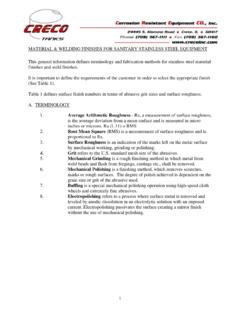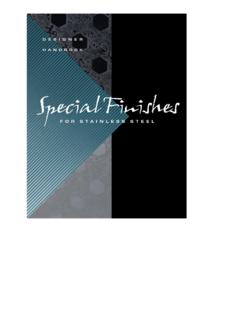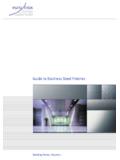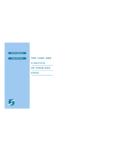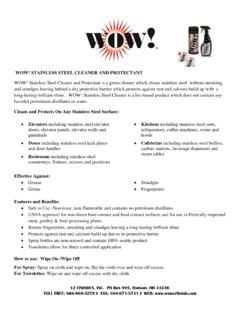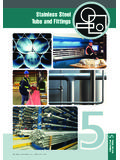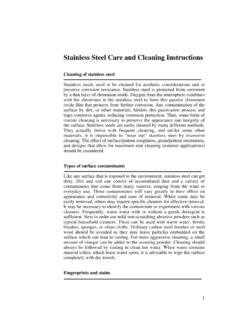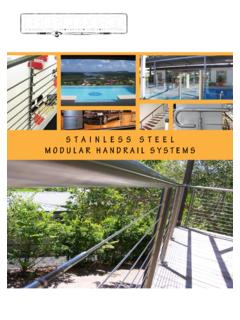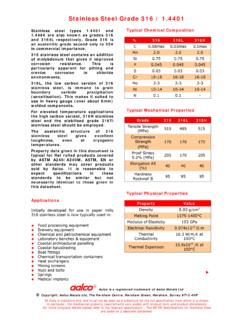Transcription of Roughness measurements of stainless steel surfaces
1 1 Roughness measurements of stainless steel surfacesIntroductionRa valueSurface Roughness is a measure of the texture of a surface. It is quantified by the vertical deviations of a real surface from its ideal form. If these deviations are great, the surface is rough, if they are small, the surface is smooth. Roughness is typically considered to be the high-frequency, short-wavelength component of a measured surface. In practice, it is often necessary to know both the ampli-tude and frequency to ensure that a surface is fit for purpose [1]. The Roughness of a surface has most commonly been measured by an instrument in which a stylus travels across the surface, the move-ment of the stylus is amplified and the signal recorded.
2 The result is generally expressed as Ra or average Roughness and is the arithme-tic average value of the deviation of the trace above and below the centre line. The value of Ra is normally measured in micrometres. ISO standards use the term CLA (Centre Line Average). Both are interpreted identically [2].Although Ra is a useful average, it does not differentiate between peaks and valleys. Very different profiles can have the same Ra value. In technical specifications, the upper limit or maximum value of the parameter is often found during inspection. For requirements specified by the upper limit ( Ra m) of a parameter, the surface is considered acceptable if not more than 16 % of all meas-ured values of the selected parameter (based on an evaluation length) exceed the value specified in the drawings or the technical product documentation.
3 To designate the upper limit of the param-eter, the symbol of the parameter is used without the max index. For requirements specified by the maximum value ( Ra max. m) of the parameter during inspection, none of the measured values of the parameter, over the entire surface under inspection, should exceed the value specified in the drawings or in the technical product documentation. To designate the maximum permissible val-ue of the parameter, the max index has to be added to the symbol of the parameter (for example Ra max). Control of surface Roughness xxxxxRaxABC?Figure 1. The principle of measuring average Roughness (Ra) [3]Figure 2.
4 Various surface profiles having the same Ra value [4]2 Roughness measurements OF stainless steel SURFACEScan be performed quickly and easily using the simplified procedure for Roughness inspection given in Annex A, EN ISO 4288 [5], [6]. Only the upper limit of Roughness is usually established not a lower lim-it. An exception is cylinder bores where oil is retained in the surface profile and a minimum Roughness is valueRq valueAn alternative measure of surface Roughness is the Rz value. ISO 4287-1:1997 [8] defines Rz as the maximum height of profile. Older documents and surface Roughness measuring instruments may still refer to Rz according to the 1984 version of this standard, which indi-cated the ten point height of irregularities.
5 Typographical detail is important: Rz refers to the current, Rz to the obsolete version of the factor for the description of surface Roughness , Rq (some-times also RMS) measures the root-mean-square deviation of a profile. The terms, definitions and parameters for determination of surface Roughness are again provided in EN ISO 4287 [7].Figure 3. The principle of measuring root-mean-square Roughness (Rq) [8]RqRaZXMean Line3 Table 1. Surface Roughness for different stainless steel finishes [9], [10], [11], [12]Surface finish EN 10088-2 Type of process route Surface Roughness as in EN 10088-2 Notes1 DHot rolled, heat treated, (shot blasted) and pick-led.
6 Rough and typically in the m range2 DCold rolled, heat treat-ed, pickled. rolled, heat treated, pickled, skin passed. Smoother than typically in the m range2 GGround Grade of grit or surface Roughness can be spec-ified. Unidirectional tex-ture, not very annealed Cold rolled, bright an-nealed. Smooth, bright, reflective. 2 JBrushed or dull polished Grade of brush or polishing belt or surface Roughness can be spec-ified. Unidirectional tex-ture, not very polishTransverse Ra < m2 PBright polished The finish is achieved by mechanical pol-ishing. The process of surface Roughness can be specified. It is a non-directional finish, reflective, with a high degree of image is worth keeping in mind that incorrect surface treatment can result in irreversible damage.
7 As an example, there is no repair procedure for a process tank delivered with a cold-rolled, bright finish (2B finish, ASTM A 480/A 480M) that exceeds a specified maximum Ra value [6]. Roughness measurements OF stainless steel SURFACES4 Roughness measurements OF stainless steel SURFACESS urface finish ASTM A 480/480 MDescriptionNotes3A linearly textured finish that can be produced by either mechanical polishing or rolling. A skilled operator can generally blend this finish. Average Ra may generally be up to 1 m*4A linearly textured finish that may be produced by either mechanical polishing or rolling. A skilled operator can generally blend this Ra may generally be up to m*5 Architectural finishes.
8 These are a separate category and can be negotiated between buyer and seller, as there are many techniques and finish variations available throughout the world.*Transverse Ra value should not exceed m6 This finish has a soft, satin appearance, typically produced by Tampico brushing of a No. 4 finish. 8 This is a highly reflective, smooth finish, typi-cally produced by polishing with successively finer grit abrasives, then buffing. Typically, very faint buffing or polishing lines may still be visible on the final product. Blending after assembly may be done by buffing.* Surface Roughness measurements differ with different instruments, labora-tories and operators.
9 There may also be overlap on measurements of surface Roughness for both No. 3 and No. 4 finish in fabricationAverage Ra mBead , should be noted that the values in the table are for orientation only and that they vary between different producers and typical surface finish. It is suggested that, as concerns surface Roughness require-ments, a possible Ra acceptance criterion should be explicitly stated, since surface finish as defined by the standards only defines the process route (such as cold rolled, heat treated, pickled, skin passed for 2B) and surface Roughness can vary from one producer to measurements OF stainless steel SURFACESS ummaryAlthough Ra values are commonly used to describe surfaces , the limits of this indicator should not be forgotten.
10 Also the notation is important: Ra m , for instance, does not have the same meaning as Ra max m . Surface designations such as 2B according to EN or No 4 finish according to ASTM encompass relatively large ranges of surface Roughness . Products which have identical designations but come from different batches or different suppliers may have noticeably different Roughness characteristics. In architectural applications where surface appearance is of great importance Roughness values alone are insufficient to characterise a surface. In this case, it is recommended that samples should be exchanged between the customer and the supplier and made part of purchase orders, to avoid later standardsISO 1302:2002 Geometrical Product Specifications (GPS) Indication of surface texture in technical product documentation (ISO 1302:2002)EN ISO 3274:1997 Geometrical product specifications (GPS) Surface texture: Profile method Nominal characteristics of contact (stylus) instruments (ISO 3274:1996)EN ISO 4287:1998/AC:2008 Geometrical product specifications (GPS) Surface texture.
